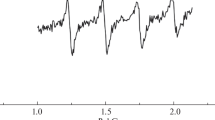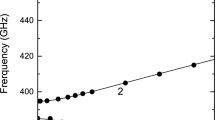Abstract
High-frequency electron paramagnetic resonance (EPR) spectra of the KPb2Cl5:Tb3+ crystal have been investigated. Three types of spectra were observed in the frequency range of 74–200 GHz. The most intensive spectrum with the resolved hyperfine structure corresponded to transitions between sublevels of the159Tb3+ ground quasi-doublet with the zero-field splitting (ZFS) close to 48 GHz. Experimental results were analyzed by the exchange charge model of the crystal field affecting terbium ions in low-symmetry Pb2+ positions with the chlorine sevenfold coordination and the charge compensating vacancy in the nearest potassium site. The calculated values ofg-factors and ZFS were in agreement with the experimental data. The nature of a broad EPR line with ZFS of about 180 GHz and of additional weak EPR lines observed as satellites of the main Tb3+ lines was discussed.
Similar content being viewed by others
References
Virovec A.V., Naumov D.U., Merculov A.A., Isaenko L.I., Pashkov V.M. in: Proceedings of the 5th International Conference “Crystals: Growth, Properties, Real Structure” (Medovoi A.I., Poljanskii E.V., eds.), vol. 1, pp. 83–86. Aleksandrov, Russia: VNIISIMS 2001.
Butvina L.N., Dianov E.M., Okhrimchuk A.G., Lichkova N.V., Zavgorodnev V.N. in: XI Feofilov Symposium on Spectroscopy of Crystals Activated by Rare-Earth and Transition Metal Ions (Kaplyanskii A.A., Malkin B.Z., Nikitin S.I., eds.), pp. 37–42. Bellingham, Wash.: SPIE — the International Society for Optical Engineering (Proceedings of the SPIE, vol. 4766) 2002.
Tarasov V.F., Shakurov G.S.: Appl. Magn. Reson.2, 571–576 (1991)
McCausland M.A.H., Mackenzie I.S.: Adv. Phys.28, 305 (1979)
Tkachuk A.M., Ivanova S.E., Isaenko L.I., Eliseev A.P., Payne S., Solarz R., Page R., Nostrand M.: Opt. Spektrosk.92, 89–101 (2002)
Malkin B.Z. in: Spectroscopy of Solids Containing Rare-Earth Ions (Kaplyanskii A., Macfarlane R.M.. eds.), chapt. 2, p. 13. Amsterdam: Elsevier 1987.
Jenkins N.W., Bowman S.R., O’Connor S., Searles S.K., Ganem J.: Opt. Mater.22, 311–320 (2003)
Zheglov E.P., Zaripov M.M., Ryzhmanov U.M.: Fiz. Tverd. Tela (Leningrad)34, 2487–2492 (1992): Zheglov E.P.: Ph.D. thesis, Kazan Physical-Technical Institute, Russian Academy of Sciences, Kazan, Russian Federation 2001.
Okhrimchuk A.G., Butvina L.N., Dianov E.M., Lichkova N.V., Zavgorodnev V.N., Sorokin E., Sorokina I. in: Technical Digest of International Quantum Electronic Conference, p. 113. Moscow: Moscow State University 2002.
Author information
Authors and Affiliations
Corresponding author
Rights and permissions
About this article
Cite this article
Shakurov, G.S., Malkin, B.Z., Zakirov, A.R. et al. High-frequency EPR of Tb3+-doped KPb2Cl5 crystal. Appl. Magn. Reson. 26, 579–586 (2004). https://doi.org/10.1007/BF03166584
Received:
Revised:
Issue Date:
DOI: https://doi.org/10.1007/BF03166584




